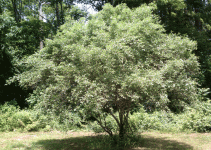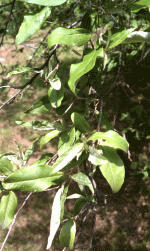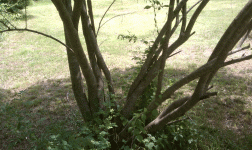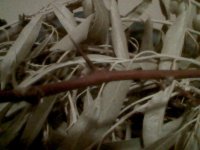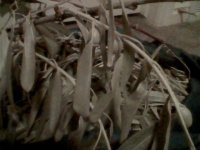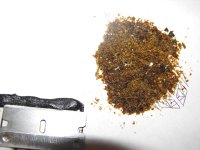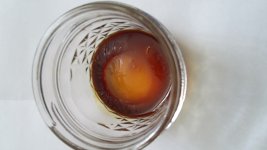-
Members of the previous forum can retrieve their temporary password here, (login and check your PM).
You are using an out of date browser. It may not display this or other websites correctly.
You should upgrade or use an alternative browser.
You should upgrade or use an alternative browser.
russian olive status ?
- Thread starter Felnik
- Start date
Migrated topic.
blueshake
nanite
I chewed 7 Elaeagnus angustifolia seeds, and it's got pretty antidepressant effect. It's 5-6 hours long. I've got dysthymia and it's pretty good for it(I'm not taking any medication for it), and I certainly feel MAOI-A effect; this serotonin effect with a bit of noradrenaline and a touch of dopamine :roll:. Im not sure if it's lowering my blood pressure(normally it's around 140/85 - light hypertension) I'll check it tomorrow (imidazoline - 1 agonism, a mark of harmane action). I think that all harmala alkaloids should be transferred to the seed coating, like in syrian rue case.
Shamelessly bumping this thread to hopefully get some more definitive IDs, assays, and hopefully methods of extraction.
WOOOO HOOOOOO! Russian Olive!
WOOOO HOOOOOO! Russian Olive!
Wax
LUVR
Ok, so I soaked a few handfuls of finely chopped Russian Olive leaves in 70% iso. The alcohol evaporated and I was left with a wet goo that smelled completely devoid of alcohol. I scraped up the goo and let the brown water fully evap. and returned to a hard brown candy like layer which was scraped up to yield shiny brown powder.
So depicted are Substance A- the black tar on the razor blade. and Substance B- the brown shiny powder.
When pressed on paper Substance A leaves a greenish imprint, I suspect this to be mainly chlorophyll...would this assumption be correct? If so then the goodies should be in Substance B, no?
Is there any way other than bioassay or fluorescence under a black light to determine what I have here?
So depicted are Substance A- the black tar on the razor blade. and Substance B- the brown shiny powder.
When pressed on paper Substance A leaves a greenish imprint, I suspect this to be mainly chlorophyll...would this assumption be correct? If so then the goodies should be in Substance B, no?
Is there any way other than bioassay or fluorescence under a black light to determine what I have here?
Attachments
I smoked some leaves and bark a while ago and got effects similar to smoking caapi leaf. Pretty much the same effect. Not saying it is safe but I was okay and that's how I tested it. Brainography. Perform brainography at your own risk.
Wax
LUVR
The only problem is I seem to have a thick skin when it comes to harmine at least. I definitely can't feel effects from smoking caapi leaf alone, I usually don't start feeling vaped harmine on top of caapi until I've had around two big bowls full, and even then it is very subtle. I'm assuming this stuff will be much more potent than pure harmine, but I'm not sure I want to be smoking large amounts just yet...we'll see.
At any rate, if I do decide to give it a whirl, is my reasoning correct and I should start off by testing the lovely looking powder rather than the black death tar?
At any rate, if I do decide to give it a whirl, is my reasoning correct and I should start off by testing the lovely looking powder rather than the black death tar?
downwardsfromzero
Boundary condition
500+ E. angustifolia seeds arrived today. Experiments will ensue both for activity of the seeds/seed coats and how well this plant might grow on a damp island in north west Europe.blueshake said:I chewed 7 Elaeagnus angustifolia seeds, and it's got pretty antidepressant effect. It's 5-6 hours long. I've got dysthymia and it's pretty good for it(I'm not taking any medication for it), and I certainly feel MAOI-A effect; this serotonin effect with a bit of noradrenaline and a touch of dopamine :roll:. Im not sure if it's lowering my blood pressure(normally it's around 140/85 - light hypertension) I'll check it tomorrow (imidazoline - 1 agonism, a mark of harmane action). I think that all harmala alkaloids should be transferred to the seed coating, like in syrian rue case.
Does anyone have anything about chemical analysis of the seeds?
downwardsfromzero
Boundary condition
So I chewed one large E. angustifolia seed 15 minutes ago. I had to break it apart with pliers at first in order to preserve my teeth. I feel a definite slight mood lift with a relaxed edge.
And I'm pretty sensitive to these things, in case you wondered.
And I'm pretty sensitive to these things, in case you wondered.
downwardsfromzero
Boundary condition
Here's some general info about this remarkable plant from Plants for a Future
PowerfulMedicine
Rising Star
Ambivalent said:ok, and what are your routes of administration and in what form do you ingest it ? the freebase which i have is inactive when ingested. when tried sublingually it hardly dissolves in my mouth, its like having sand. are you saying that your freebase extract has different characteristics ?
I'm bumping this thread because I just wanted to point out that Felnik is not using freebase alkaloids. He salted out the alkaloids ala Manske tek, so he has the hydrochloride form.
Maybe your alkaloids don't seem active because freebase forms tend to be less suitable for oral and sublingual use. Freebase harmala alkaloids aren't soluble in water which can make it them more difficult to absorb. Smoking would be a better route if you have freebase. Or just acidify the freebase to produce a salt form.
I hope to be working with russian olive in the coming spring. Maybe even earlier. I just need to find some trees that I can collect from. Russian grows like crazy along many freeways in my area, but they are hard to access and might not be the healthiest choice. I've also seen single trees in people's front yards, but I'm reluctant to collect from these as it would be suspicious and I don't want to damage their property.
Powerfulmeducine I'm sure if it's along the highways it will be everywhere . Try and find an
Empty lot someplace or along a river or stream. Workable material should be easy to find
The tree actually will self destruct itself once it reaches a certain age by putting out low branches that
Become too heavy to support . A grove of them will have plenty of dead branches all around the bases
Of the trees . Each tree puts out an obscene amount
Of seeds each season . It grows very fast and will spread in an area in a
Very short time . They are literally everywhere in my area .
I still don't understand why More people haven't tried a simple mansk
Salt extraction . It yields a small amount of brown powder that is incredibly
Synergistic with spice. It really don't understand why more people have not
Worked with this. The potential is huge . It's not caapi but it's extremely interesting
In its own right and I still believe it's an untapped amazing plant teacher.
Empty lot someplace or along a river or stream. Workable material should be easy to find
The tree actually will self destruct itself once it reaches a certain age by putting out low branches that
Become too heavy to support . A grove of them will have plenty of dead branches all around the bases
Of the trees . Each tree puts out an obscene amount
Of seeds each season . It grows very fast and will spread in an area in a
Very short time . They are literally everywhere in my area .
I still don't understand why More people haven't tried a simple mansk
Salt extraction . It yields a small amount of brown powder that is incredibly
Synergistic with spice. It really don't understand why more people have not
Worked with this. The potential is huge . It's not caapi but it's extremely interesting
In its own right and I still believe it's an untapped amazing plant teacher.
PowerfulMedicine
Rising Star
Russian olive actually isn't everywhere in my area thankfully. I've been looking for a few years now (although I haven't looked particularly hard).
I live in an urban area, but with a lot of parks and forest preserves. Around here, russian olive is rarely planted as a yard tree and I've never seen it in empty lots.
The forest preserves are actually relatively high quality and surprisingly undisturbed. Russian Olive hasn't invaded the forest closest to my house yet, although buckthorn can be a problem in some places.
I'm just gonna have to keep looking. Right now I'm thinking that train tracks and old railroad right-of-ways will likely be my best bet for finding easily accessible trees.
I live in an urban area, but with a lot of parks and forest preserves. Around here, russian olive is rarely planted as a yard tree and I've never seen it in empty lots.
The forest preserves are actually relatively high quality and surprisingly undisturbed. Russian Olive hasn't invaded the forest closest to my house yet, although buckthorn can be a problem in some places.
I'm just gonna have to keep looking. Right now I'm thinking that train tracks and old railroad right-of-ways will likely be my best bet for finding easily accessible trees.
blueshake
nanite
I extracted bark from sea-buckthorn which also contains harmalas, more than oleasters probably. Bark was harvested during dusk for best alkaloid content.
Tannin content was reduced with gelatin tek (though egg whites would have been easier to clean up) - IMHO this is a must-be for plants from oleaster family, they have a lot of different tannins from different types.
Tried to reduce it with sodium carbonate/bicarbonate (pH around 10,5 so I think it isn't enough; bicarbonate wasn't fully converted) but that didn't work.
Freezed it to get out most of tanned gelatin in the form of brown goo. Filtered and added sodium hydroxide to raise the pH, nothing happened. After few hours something precipitated looking like very small gliterry crystals.
There isn't much of it and it's possible that during the extraction some of harmalas precipitated, and I accidentally discarded them... Will try to clean them from the rest of the solution, and post a pic then.
Tannin content was reduced with gelatin tek (though egg whites would have been easier to clean up) - IMHO this is a must-be for plants from oleaster family, they have a lot of different tannins from different types.
Tried to reduce it with sodium carbonate/bicarbonate (pH around 10,5 so I think it isn't enough; bicarbonate wasn't fully converted) but that didn't work.
Freezed it to get out most of tanned gelatin in the form of brown goo. Filtered and added sodium hydroxide to raise the pH, nothing happened. After few hours something precipitated looking like very small gliterry crystals.
There isn't much of it and it's possible that during the extraction some of harmalas precipitated, and I accidentally discarded them... Will try to clean them from the rest of the solution, and post a pic then.
Re-reading this thread got me excited about the plant all over again. I'm not in one of the blue or purple states, and in fact can grow caapi quite successfully here. As far as I can determine E. augustifolia doesn't occur here except as a rare ornamental, and I've lived in this area for 16 years. Nevertheless... Today I happened upon a first class mom-and-pop nursery in a neighboring city and guess what they had in stock? I came away with a nice specimen in a five gallon pot for eleven bucks as well as a few nice Delospermas and some Mimosa strigulosa.
Now I just need to find a spot on my humble 1/4 acre to accomodate it.
So thanks for piquing my interest guys. Will post any results I get once it grows out to the point where I can work with it.
Now I just need to find a spot on my humble 1/4 acre to accomodate it.
So thanks for piquing my interest guys. Will post any results I get once it grows out to the point where I can work with it.
I live in the land of invasive exotics (peninsular Deep South) and the plant is not listed as invasive by the state, nor do we show up on any range map for the plant. There must be something in the climate here that prevents it from roaming, probably the long hot humid summers. And the people at the nursery said it's not a big seller anyway. So I think I'm OK planting it out.
Besides I think we need more than just one or two voices on the subject and growing my own seems to be my only option at this point, unless somebody want to mail me some dried material. The potential of Eleagnus as a harmala source is huge and if your experience proves to be typical it could be the solution the aya analog movement has been seeking for many years.
Besides I think we need more than just one or two voices on the subject and growing my own seems to be my only option at this point, unless somebody want to mail me some dried material. The potential of Eleagnus as a harmala source is huge and if your experience proves to be typical it could be the solution the aya analog movement has been seeking for many years.
GreenDMT
Rising Star
Please repost link(the link is broken) and I will attach the article.Dorge said:Damn that PDF costs Metapress | A Fast Growing Resource for Young Entrepreneurs
35$ spendy
Delving back into some research on this species, I found the following writeup on reddit, originating from a post on shroomery:
I suspect many of the failures reported previously with a/b extraction in this and other threads may be the result of a combination of inadequate amounts of starting material and inflated expectations set by vastly higher yielding B. caapi and P. harmala extractions.
With such low yields this falls alongside phalaris in the "the result is not really worth the effort" category, what with other sources such P. harmala being readily available. Still, it's promising to see someone succeed with this species and know that it is a viable (if impractical) option.
It appears at least one person has had success with a standard a/b extraction. However the reported yield was quite low, only about 200 mg out of 5 lbs of material (about .009%). This is significantly less than the expected yield from the bark of a mature tree (.2%), as reported in net lore, which as far as I can tell all originally traces back to Dr. Dukes Database.Elaeagnus derived harmala powder
Materials
mature Elaeagnus angustifolia bark/rootbark
Distilled H2O
HCl
NaOH (can be substituted with NH4)
Boiling vessel
(atleast 2) Glass or ceramic reaction vessels
Separatory funnel or high capacity syringe
Non-reactive stirrer
Evaporation tray
Process
1. I gathered about 5 lbs worth of young shoots and dead branches from a Russian olive in my backyard. Though leaves and fruits could technically be used, like ayahuasca, I hypothesize that the alkaloids occur in much greater concentrations within the bark. The tree I used was too young for me to be able to strip bark from, unlike older specimens which can donate their old skin just fine. The branches just barely yielded a single active dose, so it definitely seems that mature bark, or root bark if possible, will generate the greatest payout for one's efforts. I consider there to be too many essential oils and fats found in the flowers, leaves,and fruits to merit their use in extraction.
2. Branches were chopped finely(shredded would be preferable) and placed in a 7 quart pot. A solution of water and 10% HCl was poured into the pot to cover plant material, then boiled for 30 minutes. Liquid was filtered and decanted into a separate container, and fresh acidified solution was added to the pot to extract the plant matter another two times.
3. Combined liquid from extracts was then concentrated to 400mL by boiling, pH adjusted to the lowside of 3 with addition of HCl.
4. I didn't have NaOH on hand, so I substituted it with NH4. Shot glass volumes were slowly stirred into solution until alkaloid precipitation was clearly visible. This was let to settle.
5. As soon as you want, liquid is separated from precipitate to be discarded into second reaction vessel.
6a. Add distilled H2O to precipitate, stir, discard liquid to the previous second reaction vessel. Repeat this step until the precipitate washes run clear.
6b. Allow discarded solution to settle for 12 hours to turn up additional precipitate, and discard liquid. The spent liquid may be saved to repeat the settling process again and again until no more alkaloids precipitate.
7. Add about 50mL of 10% HCl solution to the precipitate to convert the freebase harmalas to a hydrochloride salt, readily dissolving into the liquid. Dilute solution with an additional 150mL distilled H2O, and allow all particulates to settle. Separate and save liquid, remaining solids can be disposed of.
8. NH4 slowly stirred into liquid until precipitation becomes apparent. Do not overbasify. This solution should be allowed to settle for at least 12 hours.
9. Precipitate should be clearly separated within the solution at this point, discard cloudy liquid to second reaction vessel. 200mL water is added to wash the precipitate, the process mirroring steps 6a & 6b. Repeat until solution's pH measure 7-8.
10. Separate precipitate from liquid, and spread out in evaporation tray in front of a fan, until dry. My extract turned out reddish-tan, lightening with age.
Yields should be weighed with a milligram scale, for accuracy.
I only came out with 200mg, just enough to feel the harmala alkaloids effect me. My bioassay was enough to give me a newfound respect for a tree that is so often looked upon by land managers with disdain. This right here is an Ayahuasca analogue that grows abundantly across America.
I have not yet tried this extract in combination with DMT, but its effects suggest that it will work marvelously.
I plan on repeating the process with mature bark, next time, as well as use NaOH instead of NH4. I performed this particular extraction way back in April and failed to photodocument it, but keep an eye out for an updated tek complete with photos, whenever I get around to sourcing some thick bark from my neighbors.
I suspect many of the failures reported previously with a/b extraction in this and other threads may be the result of a combination of inadequate amounts of starting material and inflated expectations set by vastly higher yielding B. caapi and P. harmala extractions.
With such low yields this falls alongside phalaris in the "the result is not really worth the effort" category, what with other sources such P. harmala being readily available. Still, it's promising to see someone succeed with this species and know that it is a viable (if impractical) option.
Considering the lack of success and repeatability others have encountered using the standard A/B and Manske extraction methods, I decided to take a different approach in my research.
Starting material was 861.1 grams of Elaeagnus angustifolia bark. Bark was a mixture of mostly lower trunk bark with some root bark, consisting of a healthy balance of both inner and outer bark layers. (Note: this bark was harvested from a large mature tree that had been uprooted by a construction company, even if they are invasive, please don't damage living trees.)
Material was left in large chunks and boiled 3 x 1 hour boils using fresh filtered water for each boil. All boils were combined and the water was reduced to a thick black resin.
The resin was mixed with a spoonful of pickling lime (Calcium hydroxide, Ca(OH)2) and rehydrated with a small amount of distilled water to make a paste. The paste was allowed to dry out overnight under a fan.
The dried paste was not so much pulled with, as dissolved into 91% rubbing alcohol (isopropyl alcohol, propan-2-ol). The alcohol was filtered through a funnel containing a coffee filter with a cotton plug in the bottom leaving a nice clear golden-brown solution. The solution was evaporated overnight under a fan leaving an orange-brown goo.
The orange-brown goo was sprinkled with a few pinches of vitamin c (Ascorbic acid) and dissolved into a minimal amount of distilled water, creating a nice orange-brown solution. This solution was again filtered through the funnel containing a fresh coffee filter and cotton plug. The filtered solution was again left to evaporate overnight under a fan resulting in a nice orange goo.
At this point the material is of sufficient quality for oral ingestion. However I wanted to proceed further and convert the material to a freebase for both a moar accurate yield and the ability to smoke the resulting product.
The orange goo was mixed with a few pinches of pickling lime (Calcium hydroxide, Ca(OH)2) and a small amount of water was added. While the water had no trouble dissolving the lime, it had little effect upon the goo and no basing reaction was noted. The goo dissolved fairly well into the water with a little agitation. This lime/water/goo mixture was allowed to dry out overnight under a fan, the presence of the lime had no noticeable effect on the look or consistency of the goo.
The dried goo-lime mixture was then submerged into a minimal amount of 91% rubbing alcohol (isopropyl alcohol, propan-2-ol), into which it was only very slightly and extremely poorly soluble, even with extensive agitation. Having failed to get the orange goo to dissolve into the alcohol, the alcohol was allowed to evaporate off of the mixture overnight under the fan. This again yielded the original orange lime-goo mixture.
To make sure all traces of lime and alcohol were removed, the material was again sprinkled with a few pinches of vitamin c (Ascorbic acid) and dissolved into a minimal amount of distilled water. The resulting orange solution was again filtered through a fresh incarnation of the funnel filter apparatus and allowed to evaporate for a day and a night under a fan yielding a nice fairly translucent orange jelly (photo attached).
6 grams of jelly was yielded from the original 861.1 grams of material giving a respectable total yield of approximately .7% alkaloids. While the material is obviously impure, a small taste test informs the pallet that it is rich with bitter alkaloids.
Bio-assay results to follow.
Starting material was 861.1 grams of Elaeagnus angustifolia bark. Bark was a mixture of mostly lower trunk bark with some root bark, consisting of a healthy balance of both inner and outer bark layers. (Note: this bark was harvested from a large mature tree that had been uprooted by a construction company, even if they are invasive, please don't damage living trees.)
Material was left in large chunks and boiled 3 x 1 hour boils using fresh filtered water for each boil. All boils were combined and the water was reduced to a thick black resin.
The resin was mixed with a spoonful of pickling lime (Calcium hydroxide, Ca(OH)2) and rehydrated with a small amount of distilled water to make a paste. The paste was allowed to dry out overnight under a fan.
The dried paste was not so much pulled with, as dissolved into 91% rubbing alcohol (isopropyl alcohol, propan-2-ol). The alcohol was filtered through a funnel containing a coffee filter with a cotton plug in the bottom leaving a nice clear golden-brown solution. The solution was evaporated overnight under a fan leaving an orange-brown goo.
The orange-brown goo was sprinkled with a few pinches of vitamin c (Ascorbic acid) and dissolved into a minimal amount of distilled water, creating a nice orange-brown solution. This solution was again filtered through the funnel containing a fresh coffee filter and cotton plug. The filtered solution was again left to evaporate overnight under a fan resulting in a nice orange goo.
At this point the material is of sufficient quality for oral ingestion. However I wanted to proceed further and convert the material to a freebase for both a moar accurate yield and the ability to smoke the resulting product.
The orange goo was mixed with a few pinches of pickling lime (Calcium hydroxide, Ca(OH)2) and a small amount of water was added. While the water had no trouble dissolving the lime, it had little effect upon the goo and no basing reaction was noted. The goo dissolved fairly well into the water with a little agitation. This lime/water/goo mixture was allowed to dry out overnight under a fan, the presence of the lime had no noticeable effect on the look or consistency of the goo.
The dried goo-lime mixture was then submerged into a minimal amount of 91% rubbing alcohol (isopropyl alcohol, propan-2-ol), into which it was only very slightly and extremely poorly soluble, even with extensive agitation. Having failed to get the orange goo to dissolve into the alcohol, the alcohol was allowed to evaporate off of the mixture overnight under the fan. This again yielded the original orange lime-goo mixture.
To make sure all traces of lime and alcohol were removed, the material was again sprinkled with a few pinches of vitamin c (Ascorbic acid) and dissolved into a minimal amount of distilled water. The resulting orange solution was again filtered through a fresh incarnation of the funnel filter apparatus and allowed to evaporate for a day and a night under a fan yielding a nice fairly translucent orange jelly (photo attached).
6 grams of jelly was yielded from the original 861.1 grams of material giving a respectable total yield of approximately .7% alkaloids. While the material is obviously impure, a small taste test informs the pallet that it is rich with bitter alkaloids.
Bio-assay results to follow.

